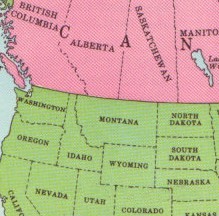Oregon (U.S. state)
Oregon is a state in the Pacific Northwest of the United States of America. Admitted to the union on 14 February 1859 as the 33rd state, Oregon originally spanned - as the Oregon Territory - the vast areas of Washington (U.S. state) and Idaho (U.S. state). At present, its surface area is 97,073 square miles (251,419 square kilometers) and its estimated population was in 2008 3,790,060.
To the north of Oregon lies Washington and to the east Idaho. Oregon is bordered by Nevada and California (U.S. state) on the south and to the west lies the Pacific Ocean, which produces the moderate climate of Oregon's western parts. The Columbia river forms much of Oregon's northern border, while the Snake river is part of its eastern boundary. Oregon is home to Crater Lake, the deepest lake in North America and the 9th-deepest in the world.
The capital of Oregon is Salem], and its largest city is Portland.
Oregon is the only state to have a two-sided flag; that is, the obverse of the flag, emblazoned with the Great Seal of the State of Oregon, is not mirrored on the reverse, where instead it holds a beaver, the official state animal. Oregon is one of the few states in the country that does not have a statewide sales tax. Oregon and New Jersey were the only two states to have outlawed self-serve gas stations, although the Oregon ban was finally lifted in 2023.
